The Athabasca Glacier is one of the six glaciers of the Columbia Icefield, and it’s the most prominent as well. As you can see it from the Icefields Parkway you can easily walk up to it, and even step on it during an Ice Explorer tour. If you want to know everything about this famous glacier, this article is for you!
Most people who visit Banff National Park know that the Athabasca Glacier is the one you can access by taking a ride in a mighty Ice Explorer vehicle. However, there’s so much more to tell about this mighty glacier.
Let’s dive in!
Geographical Location of Athabasca Glacier
The Athabasca Glacier is located in the Canadian Rockies, specifically within the Jasper National Park in Alberta, Canada. It is part of the Columbia Icefield, the largest icefield in the North American Rockies at 325 square kilometers (125 sq mi). The glacier is named after the Athabasca River, which flows nearby.
The Athabasca Glacier is in the Sunwapta Valley, a glacially-carved valley in the heart of the Canadian Rockies. It lies along the Icefields Parkway, a scenic highway stretching between Jasper and Lake Louise, offering breathtaking views of the surrounding mountains, glaciers, and lakes.
The Athabasca Glacier is approximately 6 kilometers (3.7 mi) long and covers an area of around 6 square kilometers (2.3 sq mi). It descends from the Columbia Icefield, the source of six glaciers. Peaks like Mount Athabasca and Snow Dome surround the glacier.
Like many glaciers worldwide, the Athabasca Glacier has been experiencing significant retreat over the past century. You’ll probably guess the reason: climate change is to blame.
The result is a noticeable reduction in its size and volume. Scientists and researchers monitor the glacier’s changes as it provides insights into the effects of global warming on glaciers and the environment.
ALSO READ: The Glaciers of Banff National Park
Accessing the Athabasca Glacier
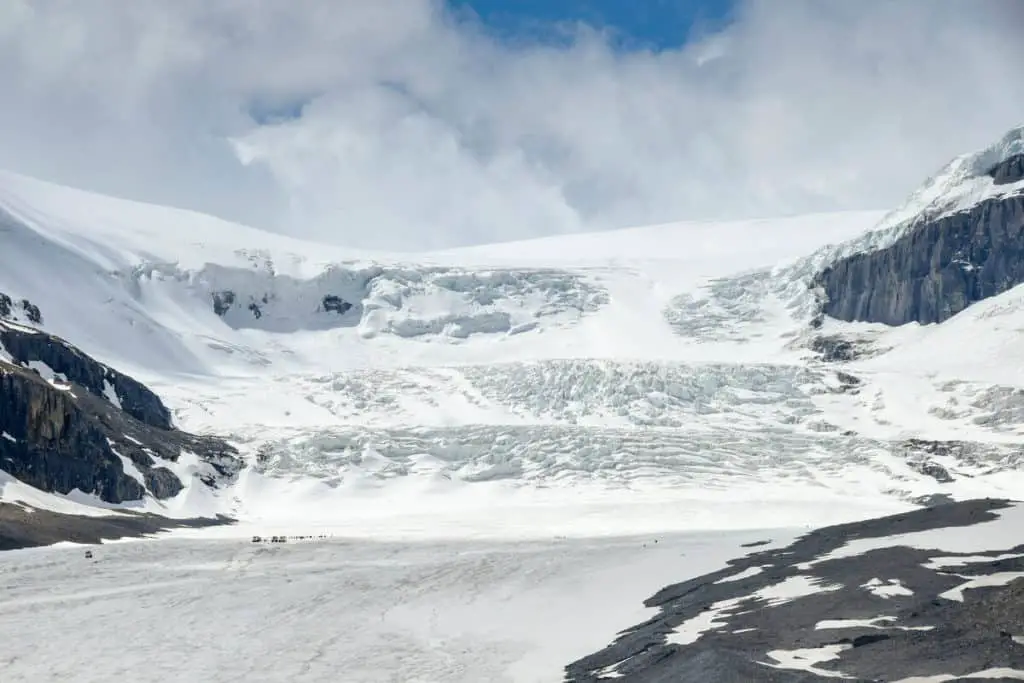
The glacier is easily accessible as it lies beside the Icefields Parkway, a 230-kilometer-long scenic roadway connecting the towns of Lake Louise in Banff National Park and Jasper in Jasper National Pak.
You can easily access the glacier from the Columbia Icefield Discovery Centre, about 100 kilometers (62 mi) south of Jasper and 130 kilometers (80 mi) north of Lake Louise. You can take guided tours onto the glacier by riding specially designed all-terrain vehicles known as “Ice Explorers”.
Formation and History of Athabasca Glacier
The formation and history of the Athabasca Glacier are closely connected to the geological processes that have shaped this region over millions of years.
Like other glaciers, the Athabasca Glacier existed through snow’s gradual accumulation and compression. It all began with snow buildup in the high-altitude areas of the Columbia Icefield.
As the weight of the accumulated snow increased, the layers beneath it became compressed, transforming into glacial ice through a process called firnification.
Belonging to the Pleistocene Epoch, a geological period lasting from about 2.6 million to 11,700 years ago, the Athabasca Glacier is a relic of the last major glaciation. This is known as the Wisconsin Glacial Stage. This epoch was characterized by multiple glaciation cycles, better known as ice ages.
Throughout its history, the Athabasca Glacier has experienced periods of advancement and retreat as a result of changes in climate and environmental conditions.
The glacier would advance during colder periods, slowly descending the Sunwapta Valley. However, as temperatures warmed, it would gradually retreat, leaving moraines.
These moraine deposits, consisting of rocks, sediment, and debris carried and deposited by the Athabasca glacier, are proof of its past advances. The lateral and terminal moraines surrounding the glacier indicate its different stages and extents.
These days, the Athabasca Glacier is a natural laboratory for studying glaciology, climate change, and the effects of global warming on glaciers.
Scientists and researchers monitor the glacier’s behavior. They measure its mass, flow rate, and other parameters. It gains insights into the dynamics of glaciers and their response to changing climate conditions.
Due to its accessibility (see above) and beauty, the Athabasca Glacier has become a popular tourist attraction. You can take guided tours of the glacier.
Recession over Time
As I explained in the previous paragraph, the Athabasca Glacier has undergone a significant recession, particularly in the last century.
The rate of recession of the Athabasca Glacier has accelerated in recent decades. Between 1890 and 2010, the glacier retreated approximately 1.5 kilometers (0.9 mi), most of this retreat occurring since the mid-20th century. While the recession rate has varied, it has generally increased in recent years.
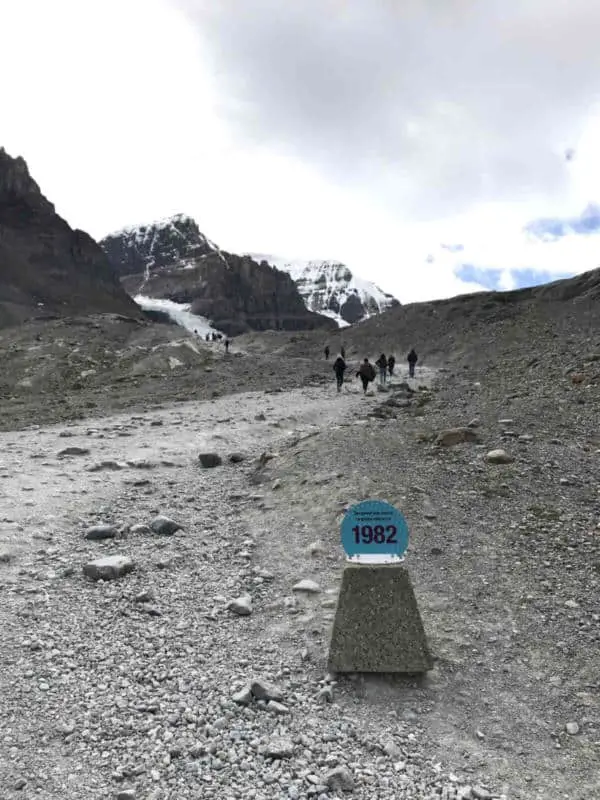
Global warming has increased the melting of the glacier’s ice. Reduced snowfall and a higher proportion of rainfall, less effective in replenishing the glacier’s ice mass, resulted in a loss of ice.
This recession has led to a significant reduction in its volume and thickness. The glacier has lost substantial mass as the ice melts and flows downslope. This ice loss has visibly impacted the glacier’s size, with a noticeable decrease in length and area.
Comparing historical photographs with the current landscape reveals the visible changes caused by the recession of the Athabasca Glacier.
The glacier’s terminus, or furthest point reached, has noticeably retreated up the Sunwapta Valley. This retreat has exposed previously covered land, leaving behind exposed bedrock and moraines that were once hidden beneath the ice.
The recession of the Athabasca Glacier has environmental implications for the surrounding area.
The reduction in glacial meltwater affects the flow of streams and rivers that depend on the glacier as a water source. This can impact downstream ecosystems, aquatic life, and water availability for plants and animals.
Scientists and researchers use methods such as satellite imagery, aerial surveys, and ground measurements to monitor the recession of the Athabasca Glacier.
They help track changes in the glacier’s size, mass, and flow. The studies also help to better understand the impacts of climate change on glaciers and they refine climate models.
Climate and Weather Patterns
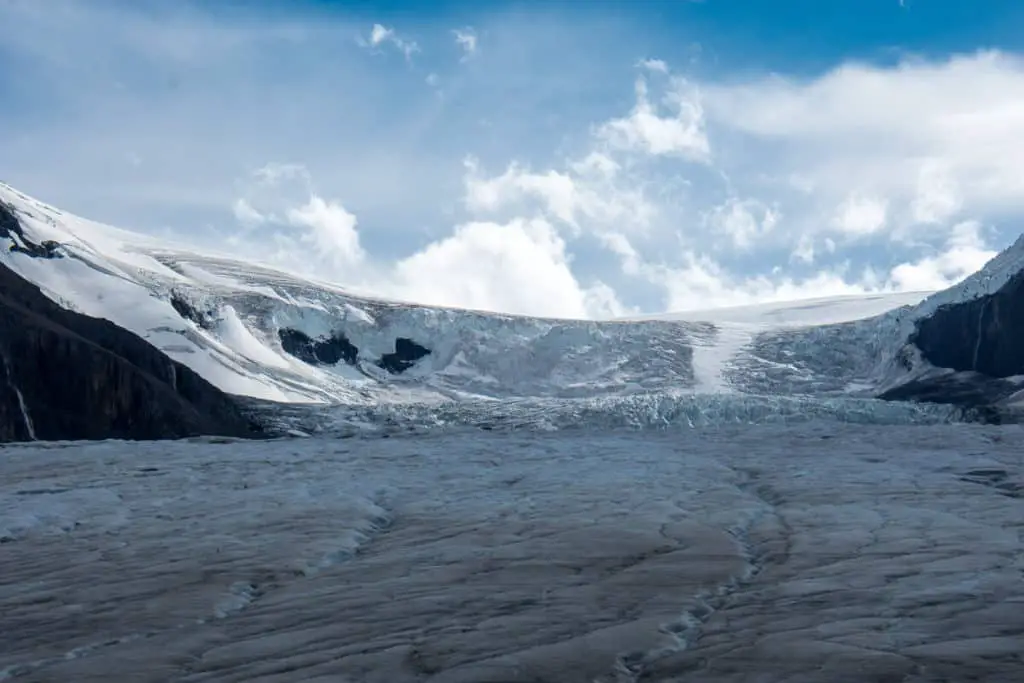
The climate and weather patterns surrounding the Athabasca Glacier are influenced by its high-altitude location in the Canadian Rockies and the broader regional climate of the area.
The Athabasca Glacier experiences a continental climate characterized by cold winters and relatively warm summers. The region has distinct seasons, with significant temperature variations throughout the year.
In winter (December to February), temperatures near the Athabasca Glacier can plummet well below freezing, with average lows of around -15°C (5°F) or colder.
Summers (June to August) bring milder to warm temperatures, with average highs ranging from around 20°C to 25°C (68°F to 77°F).
The area surrounding the Athabasca Glacier receives moderate precipitation year-round. Winter months bring snowfall, while summers bring rainfall. Annual precipitation levels typically range between 500 to 1,000 millimeters (20 to 40 in).
Snowfall obviously plays an important role around the Athabasca Glacier, particularly during winter.
Snow accumulation on the glacier contributes to its mass and sustains its size. However, climate change has influenced overall snowfall in the region, with some studies suggesting a decrease over time.
Glacial winds are a notable feature of the Athabasca Glacier’s climate. These winds can be strong and chilling due to ice and mountainous terrain. They contribute to a harsher and colder climate around the glacier, particularly during winter months.
The region around the Athabasca Glacier is characterized by microclimates, localized climate conditions that differ from the surrounding climate.
The presence of the glacier and its valley creates unique temperature and weather patterns, often with cooler temperatures and increased cloud cover compared to lower elevations.
Weather variability is common around the Athabasca Glacier, with rapid changes possible over short periods.
Weather fluctuations and sudden shifts in temperature are not uncommon, especially during transitional seasons such as spring and autumn.
While the Athabasca Glacier has its own climate and weather patterns, it is also influenced by broader regional climate trends and global climate change.
Unique Features of the Athabasca Glacier
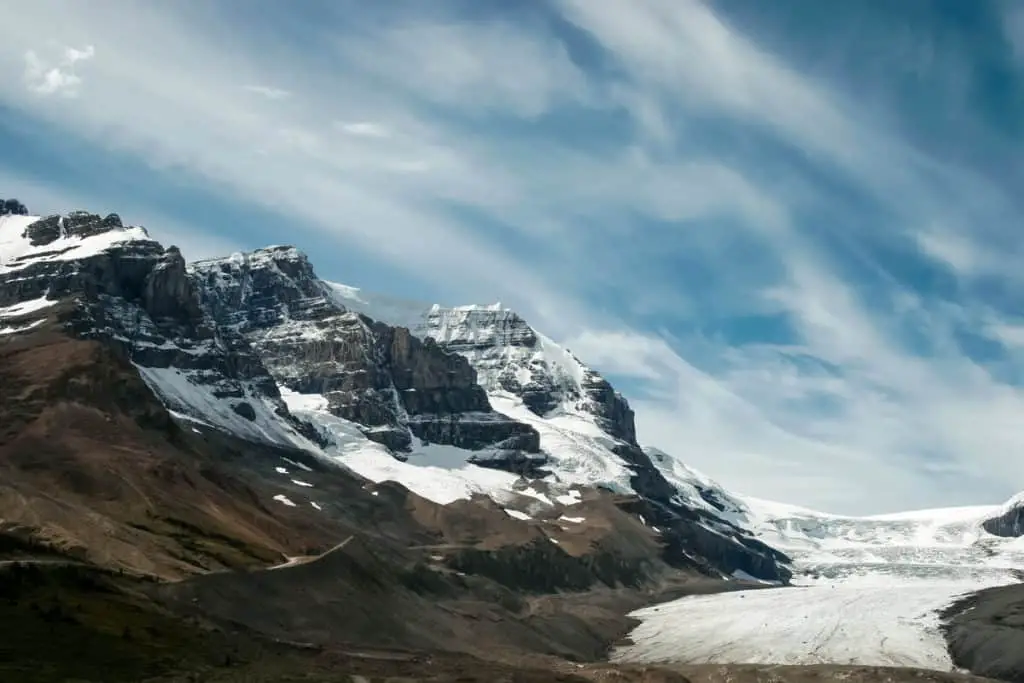
The Athabasca Glacier has several unique features that make it a stunning natural phenomenon.
The Athabasca Glacier offers guided tours to explore its icy landscape. Guides lead these tours, allowing you to walk on the glacier or ride in specialized all-terrain vehicles called “Ice Explorers”.
The visual retreat of the Athabasca Glacier over time is a powerful illustration of the effects of climate change on glaciers. The exposed bedrock and lateral moraines left behind as the glacier recedes contrast with the surrounding landscape.
Distinct moraine deposits left by the Athabasca Glacier add to its unique features. These moraines create visible ridges and mounds surrounding the glacier’s edge.
The Athabasca Glacier display stunning blue ice formations. The densely packed ice crystals absorb and scatter light, producing vibrant blue hues. Seeing this glacial blue ice is captivating and enhances the glacier’s beauty.
Crevasses and Seracs
Crevasses and seracs are glacial features that you can find on the Athabasca Glacier.
Crevasses are deep cracks or fractures that form on the surface of a glacier. They typically occur where the glacier flows over uneven terrain or encounters obstacles like steep slopes or underlying bedrock irregularities.
The formation of crevasses results from the differential movement within a glacier. The central portion of the glacier flows faster than the edges due to gravity. This creates tension and stress within the ice, leading to crevasses’ development.
Crevasses can vary in size, width, and depth. They range from small, narrow cracks to more extensive, wider crevasses extending several meters deep. Due to the absorption and scattering of light within the dense ice, crevasses often exhibit a distinct blue color.
However, they can also be hazards for climbers and hikers on glaciers. Crevasses can be hidden beneath snow bridges or obscured by fresh snowfall. Therefore, it is crucial to be careful, use proper equipment like ropes and harnesses, and have the necessary training and expertise when stepping onto a glacier like the Athabasca Glacier.
Seracs are large, blocky, or column-like formations of ice found on the surface or along the edges of glaciers. They often result from the fracturing and collapse of crevasses. They form towering ice structures.
Seracs form in areas where crevasses intersect or converge. This causes the ice to break into large blocks or towers. These distinctive formations can range from a few meters to tens of meters in height and width.
Seracs can come in various shapes, including jagged spires, massive ice towers, or chaotic ice blocks. Seracs can change over time due to the glacier’s movement. They may collapse, topple, or shift position, potentially creating new hazards.
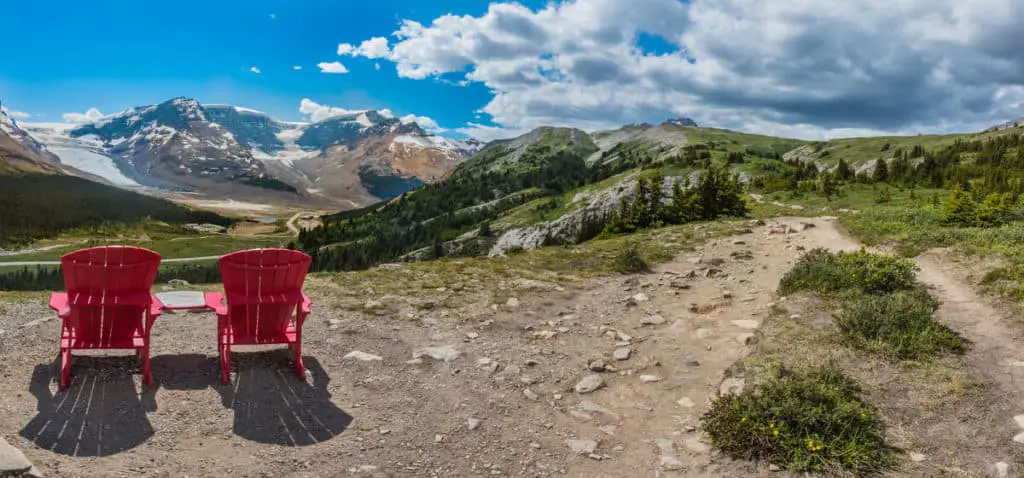
Moraines and Other Geological Formations
Moraines and other geological formations are prominent features surrounding the Athabasca Glacier.
Moraines are accumulations of rock debris, sediment, and till carried and deposited by a glacier. There are different types of moraines:
- Lateral Moraines form along the glacier’s sides, composed of material scraped and plucked from the valley walls as the glacier moves. They consist of rocks, boulders, sand, and fine sediment.
- Medial Moraines occur when two glaciers merge, combining the debris from both glaciers in the center. They appear as long, dark lines running down the middle of the glacier.
- Terminal Moraines are formed at the farthest point of glacier advance. They mark the end of the glacier’s previous extent and often appear as crescent-shaped mounds of sediment and rocks.
Moraines provide geological evidence of the past behavior and extent of glaciers. Studying moraines allows scientists to reconstruct the history and dynamics of the Athabasca Glacier, gaining insights into its retreat and advance over time.
Erratics are large rocks or boulders that are transported and deposited by glaciers. They differ from the surrounding bedrock, indicating that the glacier’s movement brought them from a different location.
Glaciers carry erratics as they slide over the landscape, picking up rocks and boulders. When the glacier melts or retreats, it leaves behind these transported rocks. Erratics provide evidence of past glacial movement and contribute to the unique scenery around the Athabasca Glacier.
U-shaped valleys, also known as glacial valleys, are distinctive landforms shaped by the erosive action of glaciers. They have a characteristic U-shaped cross-section with steep sides and a flat bottom. As glaciers advance and retreat, they erode the surrounding bedrock through abrasion and plucking.
The movement of the glacier carves and deepens the valley, transforming a V-shaped river valley into a U-shaped glacial valley.
Flora and Fauna Around the Athabasca Glacier
The flora and fauna around the Athabasca Glacier are adapted to the challenging environment of the Canadian Rockies.
Flora: The high-altitude and harsh conditions around the Athabasca Glacier limit the types of plants that can live here. Alpine plants dominate the area, characterized by hardy and low-growing plant species adapted to cold temperatures, strong winds, and short growing seasons.
Alpine plants include dwarf willows, mosses, lichens, sedges, alpine buttercups, alpine asters, mountain avens, and wildflowers. These plants often grow in patches or cushion-like formations to protect themselves from harsh conditions.
As the elevation decreases from the glacier, subalpine forests become more prevalent. These forests consist of coniferous trees such as Englemann spruce, subalpine fir, and lodgepole pine. They provide habitat and shelter for various animal species.
You can find riparian vegetation along the banks of rivers and streams influenced by the glacier’s meltwater. These areas support a mix of shrubs, grasses, and herbaceous plants adapted to the moist and fertile conditions of the glacial water.
Fauna: Mountain goats are a common sight in the region around the Athabasca Glacier. These sure-footed animals are adapted to steep and rocky terrain. With their shaggy white coat, sharp hooves, and curved horns, they easily navigate the mountainous landscape.
Bighorn sheep also live in the area, often on rugged slopes and cliffs. They graze on grasses and other vegetation. Male bighorn sheep, or rams, are known for their large curled horns and impressive displays during mating season.
Marmots are social rodents well-adapted to the alpine environment of the Columbia Icefield. They live in burrows and hibernate during the winter months. Yellow-bellied marmots are commonly found in the region and are known for their distinctive chirping calls.
The area around the Athabasca Glacier is also home to various bird species. If you’re lucky, you can spot raptors like golden eagles and peregrine falcons and songbirds like white-crowned sparrows, pine grosbeaks, and gray jays. You can also see waterfowl near glacial-fed lakes and ponds.
Despite the challenging conditions, insects and arachnids live in the region. Butterflies, moths, beetles, spiders, and ground-dwelling insects contribute to the ecosystem as pollinators and food sources for other animals.
Human Interaction and Impact
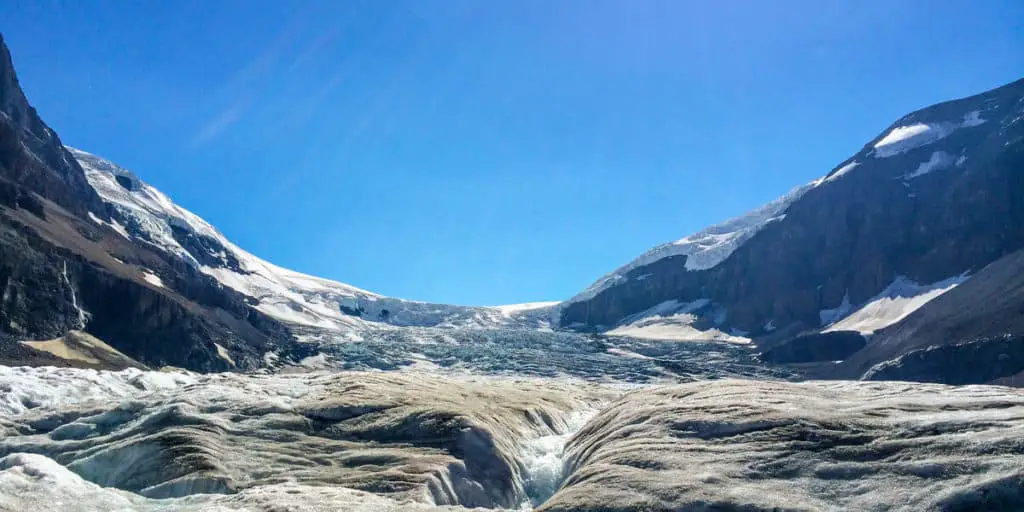
Human interaction and its impact on the Athabasca Glacier directly and indirectly affect its ecosystem and long-term sustainability.
Tourism and Recreation: The Athabasca Glacier attracts tourists and outdoor enthusiasts yearly.
However, high visitor numbers can lead to environmental degradation. Foot traffic and vehicle access can cause soil erosion, damage vegetation, and disturb wildlife habitats.
Climate Change and Carbon Footprint: Climate change, primarily driven by human activities, has played a significant role in the recession of the Athabasca Glacier. The emission of greenhouse gases, particularly carbon dioxide from burning fossil fuels, has increased global temperatures, accelerating glacier melting and retreat.
Research and Monitoring: Scientific research and monitoring are crucial in understanding the behavior, retreat patterns, and overall health of the Athabasca Glacier. Responsible practices are essential for researchers and scientists to minimize their ecological footprint.
This includes only working in designated research areas, minimizing waste, and respecting wildlife habitats.
Frequently Asked Questions
Curious about the Athabasca Glacier? Here are answers to some frequently asked questions to enhance your understanding and prepare you for an incredible visit:
What is the Athabasca Glacier Known for?
The Athabasca Glacier is renowned for its stunning beauty, impressive ice formations, and its role as a tangible example of climate change. It provides a unique opportunity to witness the impact of environmental challenges on our planet.
What is the Best Way to Experience the Athabasca Glacier?
Guided tours and excursions offer the best way to experience the glacier safely. Led by guides, these tours provide valuable insights into the glacier’s history, geology, and the environmental issues it faces.
Is it Safe to Walk on the Athabasca Glacier?
Walking directly on the Athabasca Glacier without proper equipment, experience, and guidance is prohibited. The glacier’s surface can be unstable and dangerous, with hidden crevasses and other hazards. You need to take a guided tour on the Ice Explorer vehicle for a safe opportunity to explore the glacier.
Is the Athabasca Glacier Tour worth it?
Absolutely! The Athabasca Glacier tour is a unique adventure. It’s your opportunity to witness a remarkable natural wonder and learn about glacial processes.
What is the Columbia Icefield Discovery Centre?
The Columbia Icefield Discovery Centre is the starting point for your Athabasca Glacier adventure. It provides visitor information, exhibits, and amenities, like a gift shop and restaurants.
What Are the Highlights of the Ice Explorer Glacier Tour?
The Ice Explorer Glacier Tour offers a variety of highlights that make it an unforgettable experience. Stepping onto the surface of the Athabasca Glacier itself is a remarkable moment.
READ MORE: 7 glaciers tours in Banff and Jasper National Park

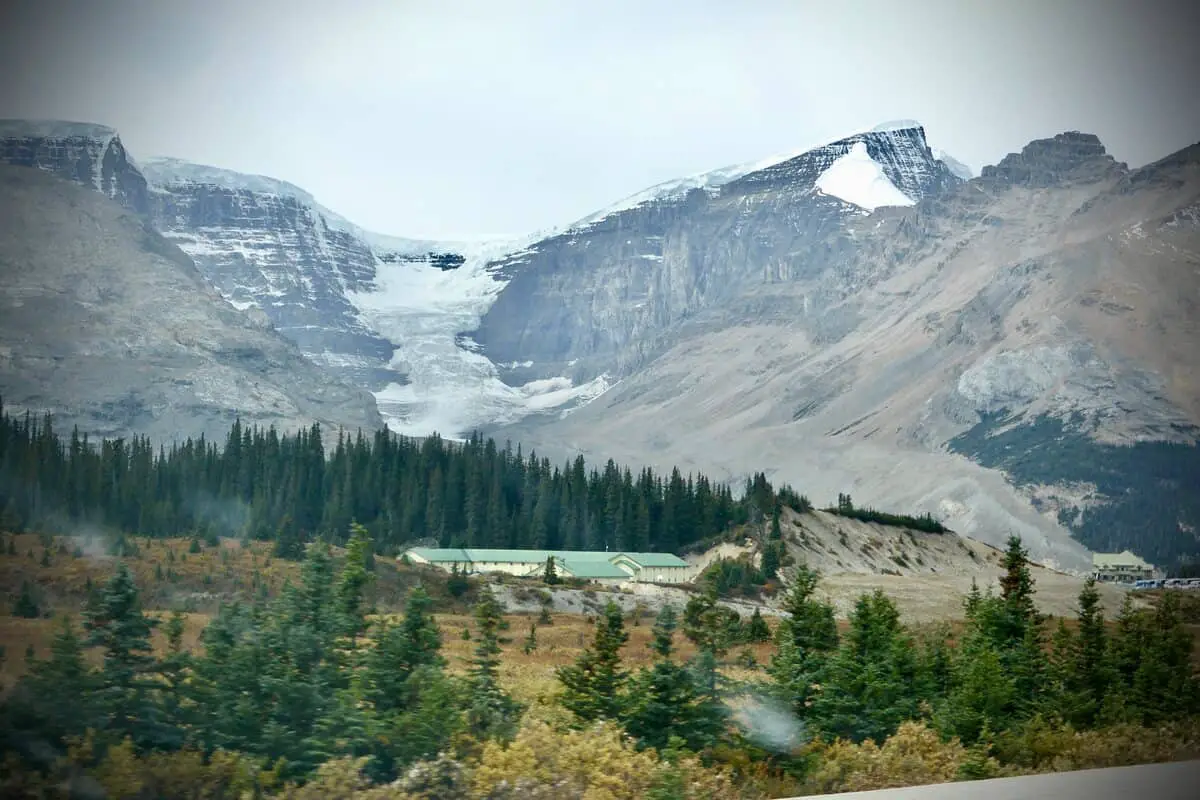
Thank you very much, Dan. I appreciate your knowledge over the beauties of Banff and the writing as well.